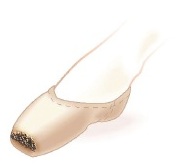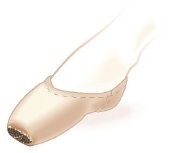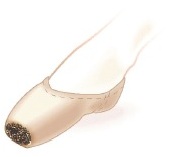What can worn pointe shoes tell me?
Whenever possible, examine the dancer’s most recent pair of pointe shoes. They can give you valuable information about her technique and needs for support, insight about how she cares for her shoes, and understanding about how well her current model and fitting are working with her foot shape and technique.
Platform
 If the platform is worn most at the front, the dancer is rolling forward over the box. This might indicate that she has worn the shoes too long (so that the shank has lost its support) or that the shank and/or box weren’t supportive enough for her. If you believe that she has worn the shoes too long, emphasize the importance of replacing pointe shoes when they lose their support. If you believe that the shoes don’t have strong-enough support for the dancer, consider choosing a stronger shank, higher vamp and/or pre-arched pointe shoe model.
If the platform is worn most at the front, the dancer is rolling forward over the box. This might indicate that she has worn the shoes too long (so that the shank has lost its support) or that the shank and/or box weren’t supportive enough for her. If you believe that she has worn the shoes too long, emphasize the importance of replacing pointe shoes when they lose their support. If you believe that the shoes don’t have strong-enough support for the dancer, consider choosing a stronger shank, higher vamp and/or pre-arched pointe shoe model.
 If the platform is worn most at the back (toward the sole), the dancer is not getting all the way onto pointe, sometimes known as “dancing on the pleats.” To help her reach full pointe, consider a lighter shank, lower vamp and/or pre-arched pointe shoe model. Dancers who are either rolling forward or not getting onto full pointe might also benefit from guidance about core strength, proper alignment and foot strength (read more about these topics in Dancing Safely on Pointe and Ballet Technique and Pointe Work).
If the platform is worn most at the back (toward the sole), the dancer is not getting all the way onto pointe, sometimes known as “dancing on the pleats.” To help her reach full pointe, consider a lighter shank, lower vamp and/or pre-arched pointe shoe model. Dancers who are either rolling forward or not getting onto full pointe might also benefit from guidance about core strength, proper alignment and foot strength (read more about these topics in Dancing Safely on Pointe and Ballet Technique and Pointe Work).
 If the platform is worn evenly, the dancer’s current pointe shoe is meeting her needs. The pointe model and its specifications (size, width, shank, vamp) have been selected well and you should consider a similar or identical shoe for the next pair.
If the platform is worn evenly, the dancer’s current pointe shoe is meeting her needs. The pointe model and its specifications (size, width, shank, vamp) have been selected well and you should consider a similar or identical shoe for the next pair.
Shank When all specifications have been properly selected, and the dancer is replacing her shoes at a good time, the shank will most likely be softened but not broken (snapped).
If the shank is snapped and the dancer has weaker feet, she may need a harder shank. If the shank is snapped and the dancer has stronger feet but very high arches, she may need a pre-arched pointe shoe model. (In this case, she may have to try more than one shank strength before finding the right one for her, because a pre-arched shank might support her more efficiently.)
A “like new” shank in a shoe that is otherwise well worn, especially in combination with a platform that shows most wear at the back, might indicate the need for a lighter shank.